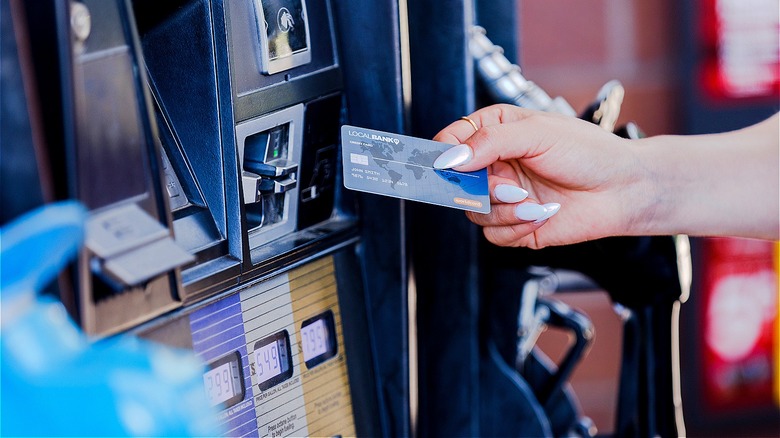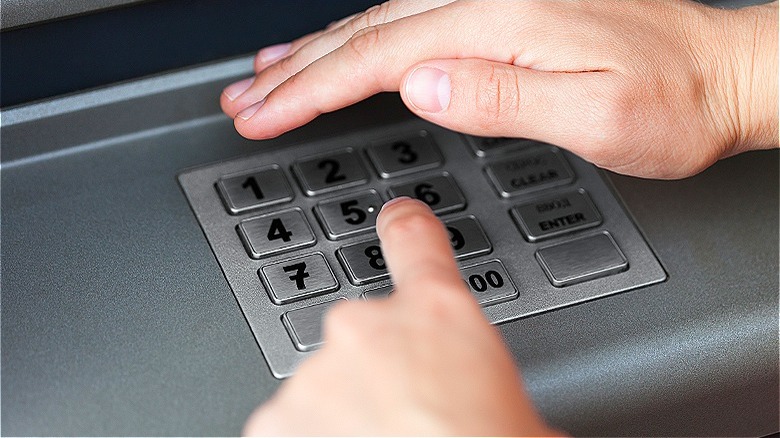How To Spot A Credit Card Skimmer Before It's Too Late
Though some personal finance gurus, like Dave Ramsey, are outspoken in their dislike of credit cards, the fact is, when used responsibly, credit cards can be a highly beneficial tool for consumers. Many credit cards reward purchases with valuable cash back or travel points. They can also provide extra credit card perks, like extended warranties, travel insurance, and price protection, all while building users a solid credit history.
With that in mind, it's no wonder why credit cards have grown immensely popular and are rapidly threatening to render cash obsolete. That said, there are some precautions to be aware of when using this convenient form of payment. Thieves frequently target credit cards to make fraudulent purchases and one way they harvest the credit card numbers and other information is by using what's called a skimmer.
A card skimmer is primarily defined as a device that's attached to credit and debit card readers to surreptitiously collect card numbers or personal identification (PIN) numbers, an authentication code that's required to complete certain transactions. Although skimmers are frequently found on ATMs and gas station pay-at-the-pump terminals, any retailer and/or restaurant and its customers can fall victim to a card skimmer being installed.
Pay particular attention at gas stations
In today's busy world, consumers are frequently in a rush to pay for goods or withdraw money from an ATM. We get that, but when possible, it's worth a moment of your time to physically examine the card slot on the payment device you're about to use. It's one of the best ways to avoid skimmers and resolving fraudulent charges can take more time than paying attention to scams to begin with.
That's because card skimmers are typically situated directly on top of the actual card reader in a piggyback fashion. If the alignment of your card in the opening doesn't seem correct or something appears to already be inserted in the credit card slot, avoid using that reader. Ditto if the graphics or arrows on the card reader have a broken pattern or if the slot appears wobbly or flexes at all. A legit card reader should be rigid and sturdy. If you're not sure, take a look at other card readers in the vicinity to see if yours looks any different.
Especially at gas station pumps, you can also look for a special strip of security tape or a sticker covering the gap where the pump's panel can be opened for servicing. If the tape is missing, cut, or appears tampered with, that can mean the internal components have been modified to steal your credit or debit card information.
Be protective of your PIN
Besides skimmers, consumers should also be aware of additional methods of harvesting important financial security measures. In particular, the PIN number for your debit card. Scammers have been known to hide tiny cameras at ATMs to record customers entering their PIN numbers. To combat the presence of discreet cameras, use your hand to shield the ATM's keypad while you enter your PIN code.
Another method to steal the PIN numbers of ATM users involves a fake keypad that overlays the machine's real keypad. Thieves can then capture the sequence of numbers entered by customers. If the buttons on an ATM feel vague or seem more difficult than usual to push, don't finish entering your PIN number. Instead, move on to a different machine elsewhere. Finally, never hand your card over to someone claiming that they can clean it. Scammers may try to convince you that they can clean a card's magnetic strip or microchip to make the card work better with readers, but it's most likely a scam to steal the card number.
If your credit card info is stolen by a skimmer, many card issuers have zero-liability protection, so the rightful cardholder won't be held responsible for the fraudulent charges(s). Besides refunding the unauthorized charges, the existing card will be canceled and a replacement will be sent to you. Note, debit cards don't typically carry as much fraud protection as credit cards, so you may want to stick to credit cards when buying gasoline via pay at the pump, which seems to be the epicenter for placing skimmers.

